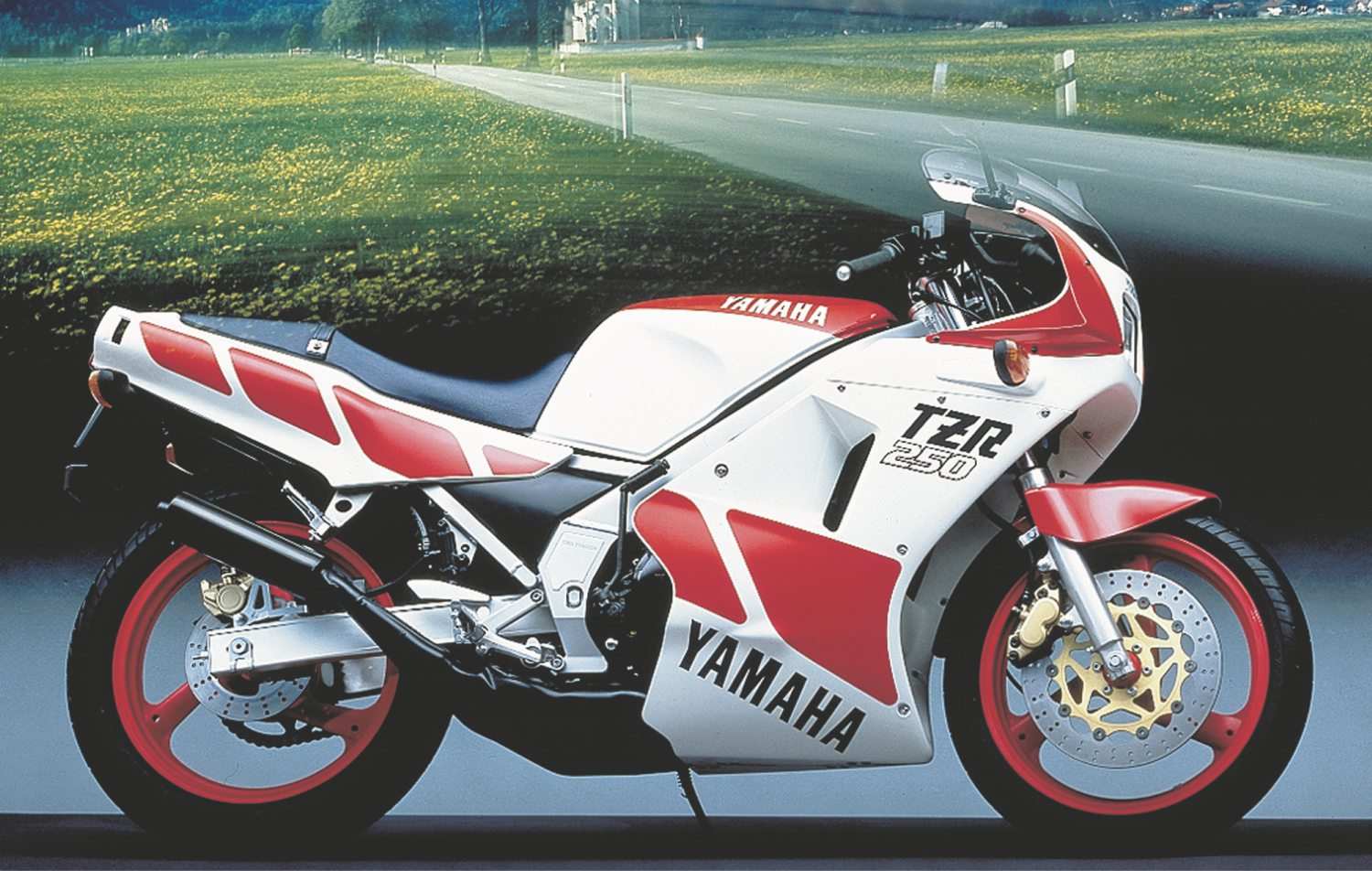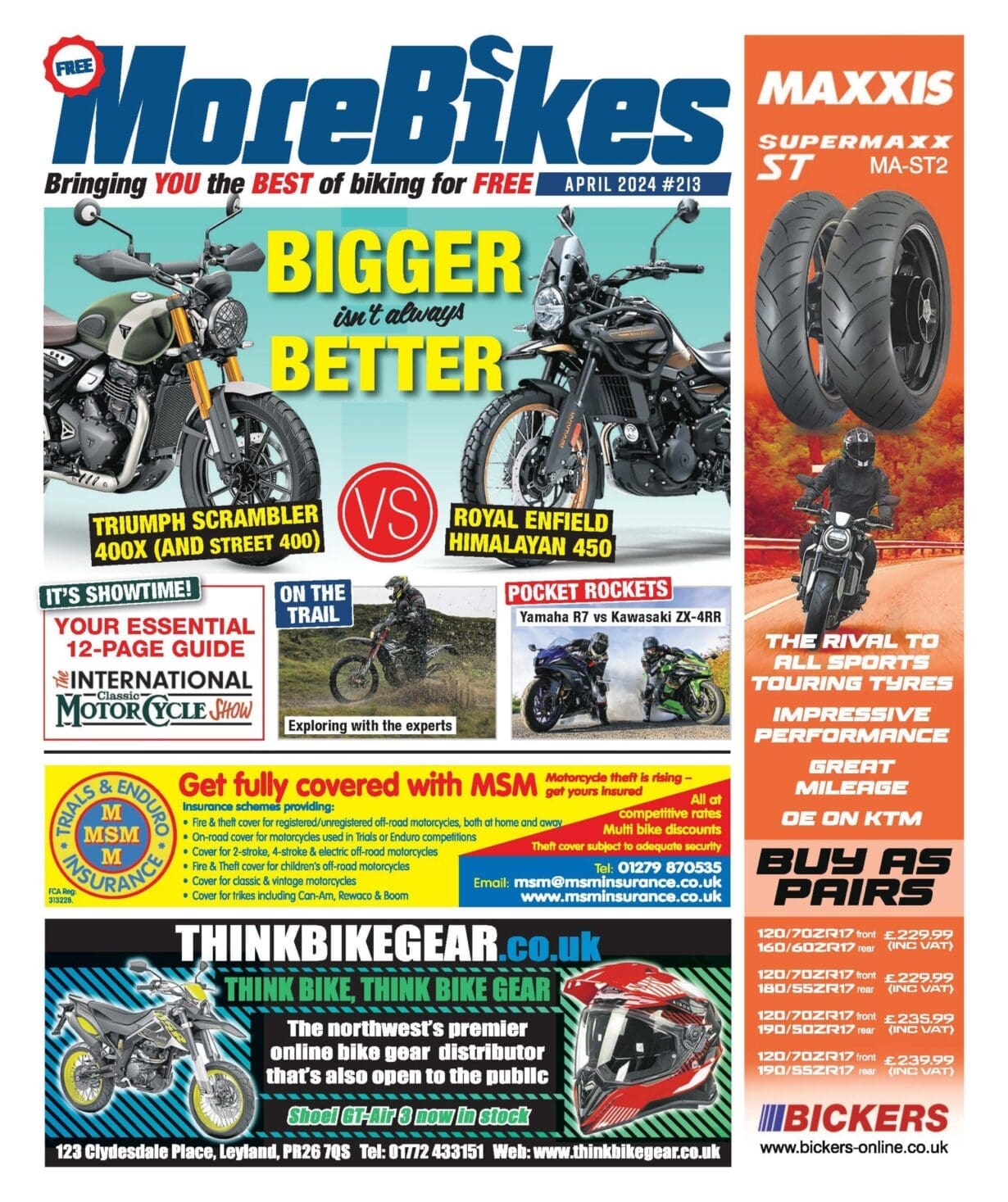The iconic race-bred 250 two-stroke that beats the competition on real-world roads.
Enjoy everything More Bikes by reading the monthly newspaper, Read FREE Online.
The mid 80s was the last great era when new two stroke motorcycles appeared with gusto. Yamaha had been busy tinkering with their RD350YPVS but needed a bike to compete in the quarter litre sector. The TZR250 lined up against Kawasaki’s all new KR1 and Suzuki’s GP lookalike RGV250, not just on the showroom floor: it was to be found on production racing grids across the UK and beyond.
The TZR250 lost out Kawasaki and Suzuki on the track, but it was more suited to the real-world situations that road riding throws up (even if its racey looks suggested otherwise). Where the other two were focused racers the TZR250 made a great road bike and could even take a passenger, just.
Engine.
No reworked old RD based engine here, the TZR250 model featured a freshly designed lump, and shared no obvious parts with the RD350YPVS that still sat in Yamaha range – it has a compact water-cooled unit with a six-speed gearbox of closely geared cogs. Reed blocks remained and were fed by a pair of Mikuni 28mm carbs. Kick-start was the only starting option. 50bhp was quoted for the new unit, though 45bhp was more believable. It featured Yamaha’s YPVS set up, which allows the shape of the exhaust port to change via a servo that pulls a pair of cables mounted on the end of the power valve, giving the 250cc motor some much needed midrange.
Handling.
With a fully fuelled weight of only 144kg, the TZR was always going to handle, its alloy frame sporting the Deltabox name (like Yamaha’s works racers) adding to the track credentials. Three-spoke wheels meant up-to-the-minute tyre technology could be exploited on its 17 inch rims. The suspension wasn’t quite up to the job of challenging the chassis, and neither was the engine ultimately. Yamaha never made a TZR350 which is a shame.
Ride.
The TZR250 is not just light but also skinny, its sculptured tank makes your knees feel like they’re practically together. The slimness continues with the saddle, not as extreme as the RGV or KR1 but not far off – definitely not plush like an RD350YPVS. The engine, when thrashed, can send a tingling through the chassis, and the brakes are more than up to the job of hauling the lightweight up. The front barke is a single 320mm disc, the same size Yamaha used on their flagship FZR1000. The engine delivers a good spread of power for a 250 two-stroke, with a satisfying top-end rush towards the red line. On the right day it can hit 120mph.
Equipment.
The TZR250 bristled with cutting edge technology when it was launched, at its heart is the Deltabox alloy box-section frame: strong and light. The lines of the frame dominate the bike’s look, like a TZ racer for the road. The neat touches like alloy bars and the cute side mounted choke lever add to the bike’s charm. The build quality is good, and even the clockset is clear and purposeful.
Finish.
Surprisingly good, the alloy components usually survive in good shape, original paintwork was thick Any non-standard paintwork hides a bike having been crashed, or worse, raced. Petrol tanks are known to rot out along the thinly welded seems – repairs are acceptable but rarely work. The brake calipers, like all Yamaha’s from this era, suffer if unloved. A ‘blue spot’ caliper from an R1/R6 will fit straight on the fork leg and is a common modification when raced.
Model history.
Launched in 1986 in the UK and ran unchanged other than paintjobs until 1990. UK bikes use the prefix 2MA, identical bikes that use a 1KT prefix are Japanese import versions, these sometime feature less power, will have integral rear indicators, a KMH clock and a headlamp that points the wrong way.
What to check.
First things to check are the frame and engine numbers: they should be matching. It’s not the end of the world if they don’t, but it’s nice if they do, especially if paying good money for an original. Check also the stamp of the numbers – many got stolen, more got crashed and repaired. They should be of equal depth and style. Looking at plenty of bikes will help here. A sump plug with a hole in it points to a racing pedigree (lock wire). Despite only being a few quid to buy a new one and hide this obvious alarm-bell, many don’t bother. Listen to the engine for any metallic noises or rumbling noises (make sure it’s stone cold on arrival). Any bike that’s had little or no use will probably need new crank seals: the parts are cheap but it’s a full engine out and strip down. The barrels thankfully aren’t Nicasiled like the KR1 etc, which makes a rebore easier and cheaper. Check what oil it’s been run on: cheap oil is a false economy, particuarly on a revvy two-stroke.
The discs can wear thanks to the poor condition calipers that drag. Replacements are plentiful and cheap. Exhausts, despite all the gunky spent two-stroke oil inside them, are prone to rusting at the manifold end. Electrics are sound. The YPVS gives no bother other than if the rubber bush-type seals leak, then the power valve unit itself can oval the engine’s barrel as it twists. Check for any visible oil leaking around the outer seal. People tend to replace them too late, and sellers will often just blame the seal. Always assume the worst!
Three overall pros.
Fun factor: the TZR is still cracking riders bike. Looks: It’s a classic, prices are already reflecting this. Cheap to maintain: For a two stroke the design is quite basic, easy to work on, and parts are readily available.
Three overall cons.
Lots of nasty overpriced examples out there. They don’t crash too well: frames are chunky yet fragile. Race bikes often end up back on the road, and are not always easy to spot.
Value for money.
The TZR250 fits nicely in the two-stroke game of Top Trumps. Prices are much cheaper than earlier LC and YPVS models but won’t always live in the shadows. Buy the best you can find, look after it and watch its value increase.
Servicing/Maintenance.
Unlike four-strokes, oil burners don’t really rely on a tight service regime. You need to make sure the engine is sound. A top end inspection is revealing and a good way to get to know your bike (though of course not really possible when buying). They like eating plugs if inferior oil is used.
Used prices
Prices don’t tend to be dictated by year – more so by condition. A basket-case/project starts at £500. For something honest and roadworthy, budget around £1,000. Beyond this it’s pure supply-and-demand on minters and restored bikes.
The ceiling is £2,500 , then you’re in to the later TZR250 models’ territory.
TECH SPEC
Engine: 249cc water-cooled parallel-twin two-stroke.
Max power (Claimed): 50bhp @ 10,000 rpm
Bore and stroke: 56.4mm x 50mm
Chassis: Alloy deltabox
Suspension: Front 37mm telescopic forks. Rear monoshock.
Brakes: Front 320mm single disc, four pot caliper. Rear 210mm disc twin pot caliper.
Wheels/tyres: Front 100/80/17 Rear 120/80/17
Wheelbase: 1375mm
Kerb weight: 144kg
Seat height: 760mm
Fuel capacity: 16 litres
Colours: Red/white . Blue/yellow.
Useful contacts
Engine woes and rebuilds: Raccoon2strokerebuilds.co.uk
Used parts: Gibsonexhausts.co.uk
Consumables: Wemoto.com
Advert
Enjoy everything More Bikes by reading the MoreBikes monthly newspaper. Click here to subscribe, or Read FREE Online.




